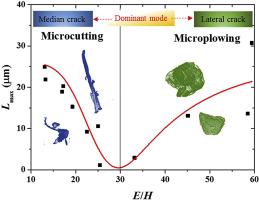Our official English website, www.x-mol.net, welcomes your
feedback! (Note: you will need to create a separate account there.)
Wear debris of friction materials for linear standing-wave ultrasonic motors: Theory and experiments
Wear ( IF 5.3 ) Pub Date : 2020-05-01 , DOI: 10.1016/j.wear.2020.203216 Yanhu Zhang , Yonghong Fu , Xijun Hua , Li Quan , Jianjun Qu
Wear ( IF 5.3 ) Pub Date : 2020-05-01 , DOI: 10.1016/j.wear.2020.203216 Yanhu Zhang , Yonghong Fu , Xijun Hua , Li Quan , Jianjun Qu

|
Abstract This study focuses on the wear debris of different friction materials for linear standing-wave ultrasonic motors (SWUMs). Wear debris with different morphology and sizes derive from wear mechanisms and has a critical influence on the contact state. The generation mechanisms of the wear debris are analyzed by using the elastic-plastic indentation mechanics and the typical morphography of the wear debris are discussed by considering of the energy balance. Oxide ceramics with high strength and fracture toughness were used as the friction materials of the driving tips, which are in contact with the carbon steel and oxide ceramic sliders. The wear tests were conducted using a homemade reciprocating apparatus. The worn surfaces and debris of different couples were investigated by scanning electron microscopy/energy dispersive spectroscopy (SEM/EDS). The statistical results of the debris size analysis were consistent with the results of the theoretical analysis of the indentation fracture mechanics. The wear debris was characterized with regard to size parameters, roundness factor, aspect ratio, and fractal dimension using image processing, and the relationships of the parameters and the wear modes are discussed. The generation mechanisms of the wear debris differ for the different friction couples due to the complex states and the differences in the mechanical properties. The plastic factor (E/H) and brittleness factor (H/KIC) are critical to the maximum dimension of the wear debris for given friction couples.
中文翻译:

线性驻波超声电机摩擦材料磨屑:理论与实验
摘要 本研究重点研究线性驻波超声电机(SWUMs)不同摩擦材料的磨屑。不同形态和尺寸的磨屑源自磨损机制,对接触状态有重要影响。运用弹塑性压痕力学分析磨屑的产生机理,并考虑能量平衡讨论磨屑的典型形貌。驱动尖端的摩擦材料采用高强度和断裂韧性的氧化物陶瓷,与碳钢和氧化物陶瓷滑块接触。磨损测试是使用自制的往复式设备进行的。通过扫描电子显微镜/能量色散光谱(SEM/EDS)研究了不同对的磨损表面和碎屑。碎屑尺寸分析的统计结果与压痕断裂力学理论分析的结果一致。采用图像处理技术对磨屑的尺寸参数、圆度因子、纵横比和分形维数进行表征,并讨论了参数与磨损模式的关系。不同摩擦副由于状态复杂、力学性能不同,磨屑的产生机制也不同。对于给定的摩擦副,塑性系数 (E/H) 和脆性系数 (H/KIC) 对磨屑的最大尺寸至关重要。碎屑尺寸分析的统计结果与压痕断裂力学理论分析的结果一致。采用图像处理技术对磨屑的尺寸参数、圆度因子、纵横比和分形维数进行表征,并讨论了参数与磨损模式的关系。不同摩擦副由于状态复杂、力学性能不同,磨屑的产生机制也不同。对于给定的摩擦副,塑性系数 (E/H) 和脆性系数 (H/KIC) 对磨屑的最大尺寸至关重要。碎屑尺寸分析的统计结果与压痕断裂力学理论分析的结果一致。采用图像处理技术对磨屑的尺寸参数、圆度因子、纵横比和分形维数进行表征,并讨论了参数与磨损模式的关系。不同摩擦副由于状态复杂、力学性能不同,磨屑的产生机制也不同。对于给定的摩擦副,塑性系数 (E/H) 和脆性系数 (H/KIC) 对磨屑的最大尺寸至关重要。讨论了使用图像处理的圆度因子、纵横比和分形维数,以及参数和磨损模式的关系。不同摩擦副由于状态复杂、力学性能不同,磨屑的产生机制也不同。对于给定的摩擦副,塑性系数 (E/H) 和脆性系数 (H/KIC) 对磨屑的最大尺寸至关重要。讨论了使用图像处理的圆度因子、纵横比和分形维数,以及参数和磨损模式的关系。不同摩擦副由于状态复杂、力学性能不同,磨屑的产生机制也不同。对于给定的摩擦副,塑性系数 (E/H) 和脆性系数 (H/KIC) 对磨屑的最大尺寸至关重要。
更新日期:2020-05-01
中文翻译:

线性驻波超声电机摩擦材料磨屑:理论与实验
摘要 本研究重点研究线性驻波超声电机(SWUMs)不同摩擦材料的磨屑。不同形态和尺寸的磨屑源自磨损机制,对接触状态有重要影响。运用弹塑性压痕力学分析磨屑的产生机理,并考虑能量平衡讨论磨屑的典型形貌。驱动尖端的摩擦材料采用高强度和断裂韧性的氧化物陶瓷,与碳钢和氧化物陶瓷滑块接触。磨损测试是使用自制的往复式设备进行的。通过扫描电子显微镜/能量色散光谱(SEM/EDS)研究了不同对的磨损表面和碎屑。碎屑尺寸分析的统计结果与压痕断裂力学理论分析的结果一致。采用图像处理技术对磨屑的尺寸参数、圆度因子、纵横比和分形维数进行表征,并讨论了参数与磨损模式的关系。不同摩擦副由于状态复杂、力学性能不同,磨屑的产生机制也不同。对于给定的摩擦副,塑性系数 (E/H) 和脆性系数 (H/KIC) 对磨屑的最大尺寸至关重要。碎屑尺寸分析的统计结果与压痕断裂力学理论分析的结果一致。采用图像处理技术对磨屑的尺寸参数、圆度因子、纵横比和分形维数进行表征,并讨论了参数与磨损模式的关系。不同摩擦副由于状态复杂、力学性能不同,磨屑的产生机制也不同。对于给定的摩擦副,塑性系数 (E/H) 和脆性系数 (H/KIC) 对磨屑的最大尺寸至关重要。碎屑尺寸分析的统计结果与压痕断裂力学理论分析的结果一致。采用图像处理技术对磨屑的尺寸参数、圆度因子、纵横比和分形维数进行表征,并讨论了参数与磨损模式的关系。不同摩擦副由于状态复杂、力学性能不同,磨屑的产生机制也不同。对于给定的摩擦副,塑性系数 (E/H) 和脆性系数 (H/KIC) 对磨屑的最大尺寸至关重要。讨论了使用图像处理的圆度因子、纵横比和分形维数,以及参数和磨损模式的关系。不同摩擦副由于状态复杂、力学性能不同,磨屑的产生机制也不同。对于给定的摩擦副,塑性系数 (E/H) 和脆性系数 (H/KIC) 对磨屑的最大尺寸至关重要。讨论了使用图像处理的圆度因子、纵横比和分形维数,以及参数和磨损模式的关系。不同摩擦副由于状态复杂、力学性能不同,磨屑的产生机制也不同。对于给定的摩擦副,塑性系数 (E/H) 和脆性系数 (H/KIC) 对磨屑的最大尺寸至关重要。











































 京公网安备 11010802027423号
京公网安备 11010802027423号